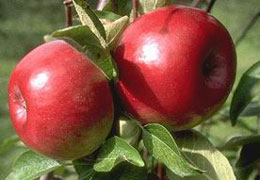


Home
Flowers &
Indoor Plants
Fruits & Nuts
Ornamentals
Vegetables
Special Topics
Resources
Glossary

 |
What about It? Apples became popular in North America in the early nineteenth century due to the work of a man named John Chapman, alias Johnny Appleseed. New York is now the nation's second leading producer of apples. What is it used for? The apple's primary use is as a food. The apple is used in baking, cooking, or eating by itself. Unfortunately for humans, tt is also popular in the animal community. Deer, for example, can often be seen browsing young twigs, foliage and fruit. Where does it grow? How do we grow it? Apples will do best in well-drained soil. On average, plant apple trees approximately 8 feet apart. After planting the trees, many people mulch to hold back weed growth. This should only be done on well-drained soils. Training and pruning apple trees is essential for good production. What are its primary problems? Apples are susceptible to apple scab, powdery mildew, fire blight, cedar-apple rust, and more! The apple maggot is the most destructive of all the insects that attack apples. How do we harvest and store it? Apples, to be stored, must be harvested before they are fully ripe. Handle apples gently to avoid bruising. For long-term storage, keep fruit in a refrigerated area or cold cellar. Store only fruit that is in excellent condition and of the highest quality.
© Copyright, Department of Horticulture, Cornell University. |






